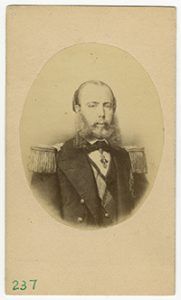The War of Reform (1857-1861)

After the Revolution of Ayutla ousted Santa Anna from power in 1855, a new government led by the liberal minded Juan Alvarez took shape. The liberals set themselves to the task of dismantling the conservative political structure to create a more modern, democratic, secular, and capitalist Mexico.
Created by Secretary of Justice Benito Juárez, Ley Juárez was the first significant piece of legislation passed by the new liberal government. The new law placed stringent restrictions on military and ecclesiastical courts which was the first step enforcing equality before the law. This caused a furious reaction from the Catholic Church and conservatives, but it also led to a schism among liberals. The moderates (moderados) favored easing the law, while the staunch liberals (puros) refused to back down. This led to Alvarez’s resignation and thus the presidency fell on Ignacio Comonfort, the Secretary of War.
In 1856, Comonfort’s Secretary of the Treasury, Miguel Lerdo de Tejada drafted a new law called Ley Lerdo. This law increased court restrictions and prohibited ecclesiastical and civil institutions from owning or administering real property not directly used day to day. The massive array of buildings and properties owned by the Church that were not used on a day to day basis were auctioned and sold. This mandate for individual ownership also meant that many communities such as indigenous communities would lose their corporate lands. Comonfort delivered another blow to the Church by giving the powers of registry back to the state. This meant that the Church no longer had control of birth, marriage, and death records.
Tensions kept mounting as delegates came together to draft the Constitution of 1857. The final draft of the constitution established a unicameral legislature and also incorporated both Ley Juárez and Ley Lerdo while also detailing equality before the law, freedom of speech, press, petition, assembly, mail, and education. It also abolished slavery, all titles of nobility, and guaranteed the right to bear arms. The Catholic Church decried the new constitution and encouraged citizens to pledge allegiance to the Church rather than the state. Tensions rose and the constitution divided the Mexican citizenry.
From 1858-1861, Mexico was engulfed in the War of the Reform or La Guerra de La Reforma. Conservatives came together to write the Plan de Tacubaya, which proclaimed the conservative general Félix Zuloaga as president. Giving into pressure, Ignacio Comonfort resigned and the charge of the presidency fell on Benito Juárez. Juárez was forced to flee north to Querétaro where liberals proclaimed him president. With two presidents, Mexico was in the midst of a bloody civil war.
The liberals established their capital in Veracruz where Juárez worked to gain support and recognition from foreign governments. With the help of his generals Ignacio Zaragoza and Jesús González Ortega, he defeated the conservative army and on New Year’s Day 1861, Juárez’s troops took Mexico City. Juárez won the presidential election in March 1861, but bickering within the party caused more tension and the administration was in a constant state of turmoil. This left the gate wide open for a foreign intervention.
The French Intervention in Mexico (1861-1867)

Juárez inherited a bankrupt government as well as outstanding debts to their military, police, and civil servants. By spring of 1861, the government owed 400,000 dollars and European creditors began demanding repayment. English, French, and Spanish leaders came together to sign the Convention of London which stated that the three nations would occupy the Mexican coasts in order to collect their money. While Spain and England sincerely just wanted their repayment, France had other plans. Led by Napoleon III, France (citing a manifest destiny), looked to the Americas to propagate French “civilization”. Napoleon III saw an opportunity to take advantage of the discontent among conservatives and Catholics in Mexico.
In 1861-1862, French troops began to mobilize and march inland to Mexico City. However, General Ignacio Zaragoza and his Brigadier General Porfirio Díaz defeated the French army. Napoleon III responded by sending 30,000 reinforcements which led to the defeat of General Jesús González Ortega and the eventual withdrawal of the Juárez government to San Luis Potosí. With control of Mexico City, Napoleon III chose the Austrian Archduke Maximilian of Hapsburg to be Emperor of Mexico.
Meanwhile, Juárez was leading a guerilla army in the north that prevented the French army from spreading. Juárez was also reaching out to the United States for support. President Lincoln contemplated support by acting on the Monroe Doctrine which decreed that any European colonization of the Americas would be viewed as an unfriendly act towards the United States. However, with the Civil War in full swing in the United States, Washington was only able to recognize Juárez’s government as legitimate. However, once the Civil War was over, about 3,000 union troops joined the Juarista army which forced Napoleon III to begin withdrawing in 1866. With a lack of troops and support, Maximilian found himself isolated and outnumbered. After attempting one last fight in Querétaro in 1866, Maximilian surrendered on May 15 and was executed June 19.
While the French Intervention left Mexican commerce and industry in shambles, it showed an increase in Mexican sovereignty and nationalism. Juárez took back Mexico City and would serve as President until his death in 1872.